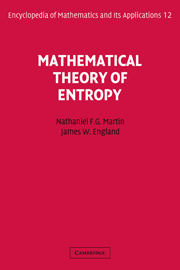Book contents
- Frontmatter
- Contents
- Editor's Statement
- Section Editor's Foreword
- Preface
- Special Symbols
- Mathematical Theory of Entropy
- Chapter 1 Topics from Probability Theory
- Chapter 2 Entropy and Information
- Chapter 3 Information Theory
- Chapter 4 Ergodic Theory
- Chapter 5 Topological Dynamics
- Chapter 6 Statistical Mechanics
- Bibliography
- Index
- About the Author
Chapter 4 - Ergodic Theory
Published online by Cambridge University Press: 05 June 2013
- Frontmatter
- Contents
- Editor's Statement
- Section Editor's Foreword
- Preface
- Special Symbols
- Mathematical Theory of Entropy
- Chapter 1 Topics from Probability Theory
- Chapter 2 Entropy and Information
- Chapter 3 Information Theory
- Chapter 4 Ergodic Theory
- Chapter 5 Topological Dynamics
- Chapter 6 Statistical Mechanics
- Bibliography
- Index
- About the Author
Summary
Introduction
Ergodic theory has its origins in the attempt to explain the macroscopic characteristics of physical systems, in particular thermodynamical systems of gases, in terms of the behavior of the microscopic structure of the system. This problem, along with other physical problems, led to what has been known as the “many body problem” in mathematics, and mathematical research on this problem led to what is now known as ergodic theory.
For example, if a gas is considered to be a large collection of molecules (thought of as point masses) which are in motion, such characteristics of the gas as its pressure, temperature, and volume should be determined by the dynamic behavior of these molecules, i.e., their positions and momenta as functions of time.
If such a system is conservative, i.e., its total energy does not change with time, then the Hamiltonian theory of dynamical systems can be used to obtain transformations on manifolds in a high dimensional Euclidean space called phase space. These manifolds in phase space consist of those states of the gas (generalized coordinates of position and momentum of each molecule) with the same total energy. The transformations preserve the measure induced by Lebesgue measure on the manifold; their construction was sketched in Section 2.8.
It is impossible to determine the microscopic state of a gas at an instant of time, so that even if the Hamilton equations of motion could be solved to find the transformation explicitly, it would not be possible to predict exactly the future states of the gas.
- Type
- Chapter
- Information
- Mathematical Theory of Entropy , pp. 147 - 212Publisher: Cambridge University PressPrint publication year: 1984



